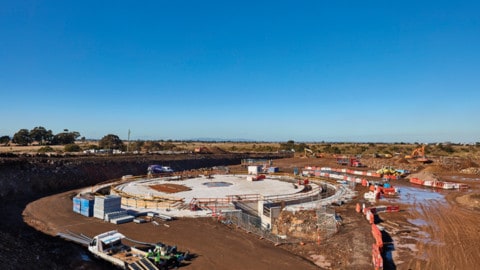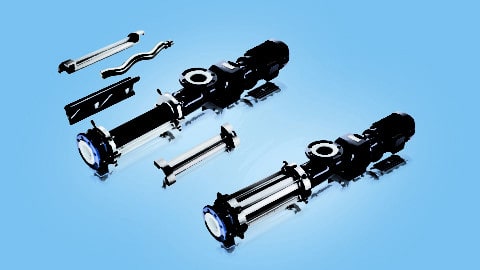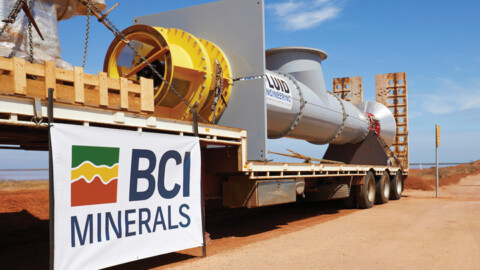By Michelle Goldsmith, Contributing Editor, Pump Industry Magazine
In mining and ore processing operations, slurry pumps provide a vital means of effectively transporting slurry over any distance. Their running costs also contribute a significant component of total operating costs, and any failure of this key piece of equipment can bring a mining project grinding to a halt. Therefore, improvements in the sustained efficiency and reliability of slurry pumps can result in substantial bottom-line benefits to mining operators.
Despite their importance, the highly demanding nature of the application and the complex set of factors affecting slurry pump performance in mining operations mean that it is still relatively common to find pumps being operated inefficiently, or in ways that reduce equipment lifespan, resulting in lower overall efficiency and higher costs for the project. Maximising slurry pump efficiency requires the correct specification and selection of pumps, and ensuring that they are optimally operated to deliver sustained efficiency and reliability over the longer term.
Handling slurry: a demanding application
Slurry pumps are required to transport large volumes of slurry, composed of target minerals and overburden suspended in a carrier fluid, to mineral extraction process plants for separation. Therefore, they must be able to handle the abrasive solids in the slurry and, in some cases, corrosive fluids.
Due to the nature of the material being pumped and the distances involved, slurry pumps are usually large and consume significant amounts of power. This is an extremely demanding application, and slurry pumps often operate 24/7, meaning that in severe conditions the wear life of wetted components can be only two to three months. Any failure or inefficiency in slurry pumping can have significant repercussions for the entire plant and project, impacting the overall profitability of mining operations.
Optimising the efficiency of slurry pumps over their entire service life requires:
• Specifying and selecting the right pump and other equipment for the application
• Ensuring the pump is operating at its best efficiency point (BEP) flow rate
• Regular monitoring and maintenance to prevent unplanned outages and declining performance
Choosing the right pump
To deliver maximum slurry pumping efficiency, the performance characteristics of the pump or pumps employed must be well matched to the unique requirements of the particular application on a project. If wrongly specified, even a pump that appears to be operating with a high efficiency can quickly become worn down and damaged.
This can result in failure or other problems, like higher power consumption and shorter pipeline equipment life, that will negate the initial efficiency and, ultimately, incur higher costs over time.
The majority of slurry pump issues are caused by a mismatch between the pump’s performance characteristics and the application requirements, either from the initial specification or due to circumstances changing since that specification.
Two main types of pumps are regularly used for transporting slurries: centrifugal pumps and positive displacement pumps. Centrifugal pumps are usually employed for flow rates from a few litres to thousands of litres per second, and can handle solid particle sizes from microscopic to large rocks up to 300mm.
However, they generally can’t develop pressures higher than 7MPa even when they are arranged in series. Their casings can be unlined or lined with internal replaceable liners, composed of materials appropriate to the features of the slurry. The wearing parts are mostly impellers, volutes and side liners.
Positive displacement pumps are often employed for pumping through very long pipelines, because of their ability to generate high pressures, which are well in excess of multistage centrifugal pumps. Their design flow rate range is limited from 50 to 1000 litres per second, due mainly to their large physical sizes, both at low and high flows.
They are best suited to transporting slurries with high concentrations of fine particles with a maximum size of about 6mm. The maximum particle size is dictated by the poppet valves, which can jam in semiopen position by large particles. Poppet valves are high wear components that need to be replaced frequently.
An array of different factors come into play when it comes to choosing the best pump for the job. These include the pump’s BEP, the characteristics of the slurry to be pumped, the distance the slurry must travel, and more. Some of the most important parameters of slurries to consider when selecting a pump include:
• The particle size, shape (angular, round, long and stringy) and hardness
• Corrosiveness
• Chemical compatibility with elastomers
• Solids concentration
• Likelihood of running dry

Hydraulic considerations and BEP match
A number of factors should be taken into account in order to select a centrifugal pump that matches the system and application’s hydraulic requirements. These include the system’s design, the required flow rate, the system resistance, and system curve.
System design – Oversizing or undersizing the pump for the application can result in the pump operating outside the range of its BEP or its allowable operating range. This can cause problems such as circulation issues, vibration, cavitation and loud operation.
Flow rate – The flow rate achieved in a pumping system is the result of the head created by the pump.
System resistance – The system resistance head is the head necessary to overcome the static head and the friction head in the pipeline. The duty point of the pump is the flow at which the head created by the pump is equal to the system resistance head.
Duty point (rated flow at differential head) – The key to successful pump selection is to accurately specify the required duty point.
The pump’s BEP flow rate is the optimum flow rate for the slurry to travel through the system at a particular impeller speed.
Net positive suction head available
Net positive suction head (NPSH) is the total absolute head at the pump suction minus the vapour head of the pumped fluid. To prevent cavitation, and the resulting damage, the system net positive suction head available (NPSHA) must be greater than the pump net positive suction head required (NPSHR), preferably with an appropriate safety margin.
Determining the required flow rate, total dynamic head to be generated by the pump, and the suction lift or NPSHA, enables the selection of a pump with a performance curve that satisfies these requirements.
The performance curves provided by pump manufacturers indicate pump efficiency, power use, and the suction lift or NPSH required for the pump’s flow range. The speed (rpm) and input power (kW) required can then be determined by plotting the required flow, total head and suction lift on the performance curves.
However, determining the requirements for slurry pumping applications is complicated by the variable individual characteristics of a slurry. The manufacturers’ performance curves are generally based on the process fluid being clear, cold water. Therefore, pumping a comparatively heavier or lighter fluid will require comparatively more or less power, and this must be taken into account in pump selection.
Other possible features of slurry pumps that could influence final pump selection include:
• Leveling (on/off control devices)
• Self-priming
• Thermal overload protection
• Non-clog
• Plug-in
• Reversible
• Dry-running capabilities
• Ease of maintenance
In reality, final selection is often a trade-off between high capital and low maintenance costs, or low capital and high maintenance costs.
Therefore, the total cost of ownership over the pump’s service life and the duration of mining operations should be taken into account and balanced.
Ensuring efficient long-term slurry pump operation
Once an appropriate pump is selected for a mining slurry application its sustained efficient operation requires that it remain in good condition. Among the key factors that impact upon pump wear is the flow at which the pump is actually operating in relation to its BEP flow rate.
Even a large, robustly-built pump running at a slow speed can experience gouging and wear that reduces the lifespan of its components, subsequently reducing efficiency and increasing its lifetime ownership costs. A pump operating at a high flow rate relative to its BEP often results in increased pipe friction losses, reduced efficiency, increased power, noise and vibration, high radial loads on bearings, and cavitation due to lack of NPSH available.
Meanwhile, when pumps operate at low flow rates relative to BEP, sedimentation and sanding can occur in pipes, causing blockages.
Other problems that may occur include recirculation, increased noise and vibration, increased radial loads on bearings due to unbalanced volute pressures, reduced seal, bearing and impeller life, low flow cavitation, and temperature rise due to dissipated energy created by ow efficiency.
Ideally, slurry pumps would be operated at 100 per cent of BEP flow, resulting in maximum efficiency and minimum wear. However, in reality this is not always possible.
Nevertheless, ensuring pumps run as close as possible to BEP will improve their performance and service life, maximising efficiency and profitability. In some cases, although a pump may be correctly specified prior to installation, changes in circumstances that result in changes to flow, such as slurry composition, can require it to operate further away from its BEP flow.
Over time, even small changes can result in significant losses of efficiency and increases to wear. As a result, to achieve optimised slurry pumping efficiency, it is important to undertake regular inspection and maintenance, and to evaluate how any changes to conditions that occur may affect the application requirements, duty point and pump BEP.
Optimising slurry pumps to maximise profitability
Slurry pumps are critical to mining and extraction operations, moving the extracted minerals and associated material to and throughout processing facilities.
This demanding application can result in significant wear to pumps, which are required to be powerful and robustly built, and often require significant amounts of power.
As a result, the pumps themselves and the power to run them contribute significantly to the overall costs of a mining operation, and improving slurry pumping efficiency can significantly increase profitability for operators within the industry.
Maximising efficiency involves determining the requirements of a given slurry pumping application and choosing the right pump for the job (with a BEP well matched to the duty flow rates), operating it as close to its BEP as possible to increase efficiency and equipment lifespan,
and undertaking smart monitoring and maintenance to sustain this efficiency over the longer term.
By following these steps, operators can increase the likelihood that their slurry pumps will be performing efficiently and reliably for a long time to come, maximising return on investment, and keeping mining operations running smoothly and profitably





















